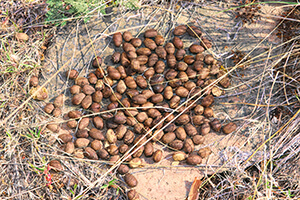
I shivered in the evening wind as a full moon ripped through the horizon like the morning sun. It looked white hot, but no warmth followed it into the sky. Huddled in my sleeping bag, I made a mental inventory of the desert sounds.
As a youngster, I always thought the desert would be quiet at night, but it’s anything but. The first odd thing I noticed was the song of frogs. They sounded like tree frogs, those green dime-sized amphibians that frolic through the flowers and stick to walls and window casements. But this was the Oregon high desert, not Frogtown. Was I misinterpreting the sound?
From somewhere downslope came the complaint of cattle, and beyond that a chorus of coyotes. First one coyote called and then another until they all burbled at once, their combined voices sounding like water gurgling in a hot cauldron. They all talked together until something caught their attention, commanding instant silence. No wonder the cattle were restless.
Sanitizing the forest floor
I awoke early enough to see a few stars winking from a cloudless sky. The moon was gone, replaced by a faint lightness. The nocturnal mammals were now silent, replaced by calling birds, prattling chipmunks, and a distant chainsaw groaning into an early start.
Although the air was too cold for bees, I hunted for flowers, trying to find places I might later search for pollinators. Frogs, too. As I scoured the stark, rocky ground for tiny blooms, I noticed a chunk of deer scat — one solitary piece — traveling across the forest floor.
Now, dung on the run is worth a closer look, so I got down on hands and knees. There, amongst several handsome piles of droppings, I found a glistening black beetle hard at work. I was overjoyed to find a companion.
She — I assume it was she — tugged at a large pellet of dry poop. With her prize clenched in her mandibles, she backed toward a small hole in the ground bookmarked by two flat rocks. She tugged and twisted, edging the thing closer to home by fits and starts. The turd was as long as the beetle but wider and taller, roughly the size of an old-fashioned jelly bean.
I watched for multiple minutes until she backed into her hole, still clamped into the dirigible-shaped treasure. After she disappeared, the dung continued to dance and shimmy at the entrance as she pulled and tugged. “You need to rethink this,” I said to her. No way was that fat prize going to fit into a tube no bigger than a soda straw.
I was amused and fascinated by her determination until, with a pop I could only imagine, the entire thing disappeared into the hole. I couldn’t believe my eyes. It was gone, she was gone, and the entrance was no bigger than before. Like stuffing an oversized cork in a wine bottle, it required a certain finesse.
Sitting cross-legged in the dirt, I waited, hoping to see a repeat performance of this marvelous trick. But she never reappeared. I was tempted to dig into the ground to see where she put the thing, but since she made such a neat job of it, I didn’t have the heart to meddle.
More than just pollinators
Whenever people talk about the insect apocalypse, I think not of pollinators but of all the insects that renew and cleanse our environment, the ones that eat dung, and the ones that feast on dead and decaying plants, animals, fungi, and microbes.
Where would we be without them if not in a cesspool of unmentionables? It’s far too easy to demonize the bugs that bother us, forgetting about the ones that keep our planet habitable. It’s unconscionable that the chemicals we choose to destroy the insects we dislike also kill the ones we depend on. Dung eaters are no less important than pollinators.
Why farther is better
Waste management is a universal problem, and honey bees have their own fecal woes. But as you might expect, all bees have unique methods of dealing with defecation that evolved throughout the bee families.
When we think of honey bee poop, we usually picture yellow rain, the kind that falls from the sky leaving sticky blobs that adhere to cars and picnic tables. Many people — men in particular — believe that honey bees actually enjoy this activity, practicing airstrikes on especially shiny or recently cleaned objects.
More likely, our beehives are close to our houses and cars, which means the density of droplets is high. According to the inverse square law, the distribution of a quantity of something such as sound, illumination, or bee poop is inversely proportional to the square of the distance from its source. Because bees radiate from a point source (the hive) into three-dimensional space, the density of the droplets decreases as you move farther away.
Okay, I know my interpretation is a stretch because bees don’t radiate evenly. In fact, they go wherever they please. But you get the idea. When avoiding bee poop, farther is better.
An unlikely ecosystem service
Ultimately, this sticky substance — at least the portion not stuck to your treasured possessions — gets washed into the soil where it decomposes, providing nutrients for plants and soil-borne organisms. All bees provide this ecosystem service, although it’s hard to think of it as a service while you’re scrubbing it from your vinyl siding. Still, it’s a straightforward process, wildly efficient, and easy to understand. And just think, the bees provide aerial application without the use of fossil fuels!
Ecosystem services are all the processes that allow humans to survive on planet Earth. These services, inherent in the natural world, are categorized and ….


